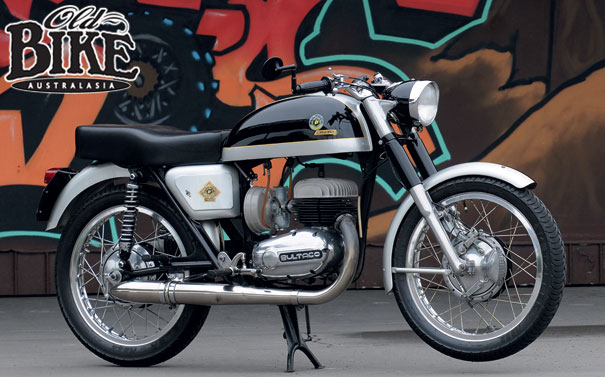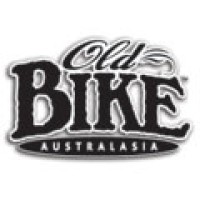Old Bike Australasia: Bultaco Metralla - Bully for you

Bulto was a director of the Montesa company, which began motorcycle production in 1944. Montesa had steadily built its business into a range of two-stroke bikes, using racing success as its main form of promotion. However the move to larger premises in 1957 coincided with a slump in the Spanish economy, and a decision by the company’s majority shareholder to suspend all racing activity met with strong disapproval from Bulto. So strong, he quit Montesa and started his own concern, taking with him several of Montesa’s key employees.
Bultaco was set up in an old farmhouse and in March 1959 launched its first model, the 125 cc Tralla 101 (Spanish for whiplash). Beautifully styled and a spirited performer, the Tralla was an instant hit, particularly after a near-standard model finished second outright in the prestigious Montjuic 24 Hour Race in Barcelona later in the year. Several features of the Tralla 101 became synonymous with all subsequent Bultacos, such as the big exhaust port and polished crankcases, and, on the road bikes, the suede strip in the centre of the seat. In 1962, the Tralla’s engine was squeezed out to 196 cc by overboring – the maximum size obtainable using the original crankcases, to create the Metralla 62, Metralla being Spanish for Shrapnel in the artillery sense. The following year, the Tralla 101 was superceded by the 102 and was basically visually identical (apart from some minor things) to the Metralla 62 in all respects except the capacity of 125 cc.
And so we come to the subject of our story, the Metralla Mk2 of 1966. Now a full 250 cc (well, 244.3 cc actually), the ‘big’ Bully sported a 5-speed gearbox, poked out 27.6 hp at 7,500 rpm and was good for a genuine 100 mph. In this respect, it came squarely into competition with the Suzuki T20, another 100 mph 250 and which carried a good deal more customer-friendly tweaks, particularly in the electrical department, than the Metralla. But in reality the two bikes were poles apart as you would expect in a Japan versus Spain situation; one perfectly behaved with impeccable attention to detail (and an automatic oiling system called Posiforce), the other a rorty little pug with a real Latin temperament and few frills.
At this point I will introduce John Somerville, the doyen of the Metralla in Australia; a man who is a self-confessed Bultacoholic (he owns over 20, including the ex-Tommy Robb factory Isle of Man machine). Some years ago John did all Metralla owners a big favour by writing the definitive book on the subject Bultaco – mi obsesion, which covers absolutely every aspect of the model, from its inception as the Trala in 1959 to its ultimate form as the Metralla GTS of 1979. The book is out of print now but if you’re contemplating a dalliance with a Metralla, you’d be well advised to seek a second hand copy.

Australian deliveries of the Metralla Mk2 began in 1966, and the first models were available in either red/silver or black/silver. John sums up the market this, “The type of person who bought these bikes fell into two categories. (1) Those who knew just how well these bikes went and were not blinded by all the chrome and lights of the Japanese bikes at the time, and (2) Those who bought them just because they were the cheapest 250 at that time (In 1967 the Metralla Mk2 had a retail price of $640.00 in NSW). The Metralla needed plenty of preventative maintenance to keep it running properly, and the replacement of all nuts with Nylock nuts and Loctite to stop bits vibrating off. The lights usually needed attention to get a few extra candle power and stop them from blowing/vibrating bulbs. Fork oil needed to be increased from the 55 cc specified to 100 cc to allow the forks to work and the rear shocks needed regular servicing. On some bikes the crank had not been properly aligned at the factory so the bike would vibrate a bit but properly align the crank and it was a very smooth and powerful engine (for 1966). Apart from that just regular maintenance was required but woe-betide the rider who did nothing!”
Spartan it may have been, but the Metralla had some very nice touches, notably the fully-enclosed rear chain. Early models used a cast alloy section to enclose the rear sprocket, with individual rubber sleeves covering the top and bottom chain run. This not only significantly prolonged the life of the chain, it kept the back end of the bike free of muck. Early fork legs had no drain plugs, which was a major inconvenience and meant each leg had to be removed to chain the oil. This was rectified on latter models.
A major difference between Australian (and European) and American models was the headlight and taillight. US regulations called for lights that were approved by various state authorities, so the normal direct lighting system was a no-go. In place of the Spanish electrics, 12-volt Lucas lights were used. American models, some of which found their way to Australia, also have high-mounted one-piece handlebars instead of the individual clip-ons for local models. Metrallas come with both 6 and 12 volt for the lighting system, and the 12 volt system is usually fitted with a Zenner diode. As John Somerville says, “The standard lights on the Metralla Mk2 as set up at the factory are reputed to be almost useless for riding at night, but they can be improved. The main killer of headlight and tail light bulbs is vibration. Fit a rubber washer on each of the headlight mount bolts, between the headlight shell and the support brackets on the front forks. To get a good headlight, replace the standard one with one from a Japanese bike; they will fit straight into the Bultaco headlight rim. These have the benefit of concentrating the light forwards (the Bultaco Hensev light reflects almost as much light up, down and sideways as forwards) and also have a rubbermounted bulb for greatly increased bulb life. A Zenner diode should be fitted to restrict the flow of excess current. To further improve your lights, disconnect the speedo light (the speedo probably doesn’t work anyway) and the high beam indicator light. If your system is 6 volts, fit a 12 volt tail light bulb, it will draw half the amps of the 6 volt bulb. Reduce the air-gap between the coils and the magneto flywheel to the absolute minimum.”
The 250 engine, although following basic twostroke principles, was a very spirited performer. Early models used a 27 mm Amal Monobloc carburetor, which was later replaced with a 30 mm Monobloc and finally a 32 mm Concentric Mk.1. Another later modification was the fitting of an oil tank inside the right hand tool box with a handoperated pump which delivers oil to the petrol tank. John Somerville describes the procedure that precedes the use of the oil tank. “Pump out 10 strokes of oil into a measuring cylinder and divide by ten to determine how much oil is pumped per stroke. When filling up with petrol, simply multiply the number of strokes of oil you pump into the tank by 25 (for a 25:1 mix) and fill the tank with this amount of petrol. I have been using the oil pump successfully on my Metralla for 31 years. It works perfectly and is very worthwhile having”.

From what has been said so far, it is obvious that as a road bike, the Metralla left a few things to be desired, particularly compared to the more sophisticated offerings from Suzuki and Yamaha at the time. But as a sports machine, it punched far above its weight. In standard form for Production Racing the Metralla was a rocket, as evidenced by its domination at Bathurst, where it won the 250 Production Race in 1967 (Kevin Fraser first, Allan Arnold second), and 1969 (Terry McDonald first, Kevin Fraser second). At Oran Park, where the Lightweight Production was one of the hardestfought races on the program, Kevin Fraser was virtually unbeatable.
A Race Kit was offered for the Metralla, and under the very loose regulations for the Isle of Man Production TT, was eligible for the 1967 event. A three-bike team of factory bikes entered by Harry Lindsay, the Bultaco importer for Southern Ireland, cleaned up the 1967 Production 250 TT, with Englishman Bill Smith first (averaging an impressive 88.63 mph) Ulsterman Tommy Robb second, and Australia’s Kevin Cass sixth. The Robb bike eventually came to Australia to Wangaratta collector Ken Lucas, and is now owned by John Somerville. The standard ‘race kit’ comprised a race-ported barrel, a piston with the inlet skirt shortened by 2 mm, a head giving 12:1 compression ratio, FEMSA electronic ignition, expansion chamber exhaust, close-ratio gearbox, bigger jets and a plastic bellmouth for the carburetor. There was also a large capacity fiberglass fuel tank with different supports and strap, a racing style seat, dropped clip-on handlebars, rear ser footrests, rear brake lever and gear lever, and a bikini-style fairing. It was a fairly straightforward job to fit the race kit to a standard Metralla, and the result was a competitive racer, at least until the Yamaha twins took over.
Only 5,508 Mk2 Metrallas were made between 1966 and 1974, so they are a comparatively rare machine today and highly sought-after. The Metralla name did survive post-1972, but in quite a different form. The Metralla GT was aimed at the US and used the redesigned engine from the later 250/370 motocross models, in a conventional full loop cradle frame with a slightly upswept exhaust silencer. This was superceded by the very similar Metralla GTS in 1977, and finally by the 1979 GTS which used cast alloy wheels instead of spoked items.





